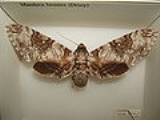
Manduca brontes
Encyclopedia
Manduca brontes is a species of moth in the family Sphingidae
. It is known from Jamaica
, Cuba
, Haiti
, Puerto Rico
, the Cayman Islands
, the Dominican Republic
and Suriname
.
Adults are on wing from April to June in Florida.
The larvae have been recorded feeding on Tecoma species (including Tecoma stans
), Fraxinus americana, Fraxinus excelsior and Fraxinus platycarpa.
Sphingidae
Sphingidae is a family of moths , commonly known as hawk moths, sphinx moths and hornworms, that includes about 1,200 species . It is best represented in the tropics but there are species in every region . They are moderate to large in size and are distinguished among moths for their rapid,...
. It is known from Jamaica
Jamaica
Jamaica is an island nation of the Greater Antilles, in length, up to in width and 10,990 square kilometres in area. It is situated in the Caribbean Sea, about south of Cuba, and west of Hispaniola, the island harbouring the nation-states Haiti and the Dominican Republic...
, Cuba
Cuba
The Republic of Cuba is an island nation in the Caribbean. The nation of Cuba consists of the main island of Cuba, the Isla de la Juventud, and several archipelagos. Havana is the largest city in Cuba and the country's capital. Santiago de Cuba is the second largest city...
, Haiti
Haiti
Haiti , officially the Republic of Haiti , is a Caribbean country. It occupies the western, smaller portion of the island of Hispaniola, in the Greater Antillean archipelago, which it shares with the Dominican Republic. Ayiti was the indigenous Taíno or Amerindian name for the island...
, Puerto Rico
Puerto Rico
Puerto Rico , officially the Commonwealth of Puerto Rico , is an unincorporated territory of the United States, located in the northeastern Caribbean, east of the Dominican Republic and west of both the United States Virgin Islands and the British Virgin Islands.Puerto Rico comprises an...
, the Cayman Islands
Cayman Islands
The Cayman Islands is a British Overseas Territory and overseas territory of the European Union located in the western Caribbean Sea. The territory comprises the three islands of Grand Cayman, Cayman Brac, and Little Cayman, located south of Cuba and northwest of Jamaica...
, the Dominican Republic
Dominican Republic
The Dominican Republic is a nation on the island of La Hispaniola, part of the Greater Antilles archipelago in the Caribbean region. The western third of the island is occupied by the nation of Haiti, making Hispaniola one of two Caribbean islands that are shared by two countries...
and Suriname
Suriname
Suriname , officially the Republic of Suriname , is a country in northern South America. It borders French Guiana to the east, Guyana to the west, Brazil to the south, and on the north by the Atlantic Ocean. Suriname was a former colony of the British and of the Dutch, and was previously known as...
.
Adults are on wing from April to June in Florida.
The larvae have been recorded feeding on Tecoma species (including Tecoma stans
Tecoma stans
Tecoma stans is a species of flowering perennial shrub in the trumpet vine family, Bignoniaceae, that is native to the Americas. Common names include Yellow Trumpetbush, Yellow Bells , Yellow Elder, Ginger-thomas, and Esperanza...
), Fraxinus americana, Fraxinus excelsior and Fraxinus platycarpa.
Subspecies
- M. brontes brontes (Jamaica and Cuba, Greater Antilles and northern South America)
- M. brontes cubensis (Kitching and Cadiou, 2000) (Cuba, Haiti, Puerto Rico, the Cayman Islands and Florida)
- M. brontes haitiensis (B.P. ClarkBenjamin Preston ClarkBenjamin Preston Clark was an American entomologist who specialised in Lepidoptera, especially Sphingidae.His worldwide collection is in the Carnegie Museum of Natural History in Pittsburg....
, 1916) (Haiti and the Dominican Republic) - M. brontes pamphilius (CramerPieter CramerPieter Cramer , was a wealthy Dutch merchant in linen and Spanish wool, and an entomologist. Cramer was the director of the Zealand Society, a scientific society located in Flushing and a member of Concordia et Libertate, based in Amsterdam...
, 1782) (Suriname)

